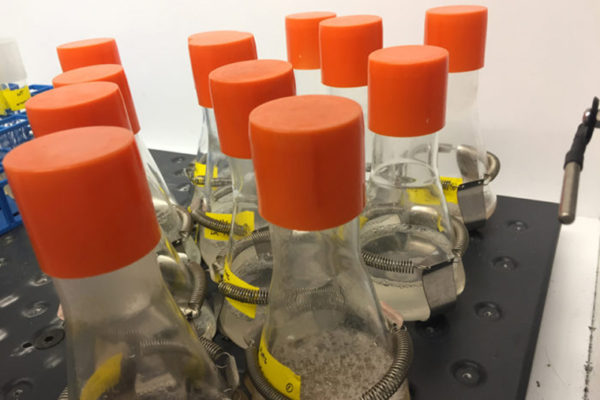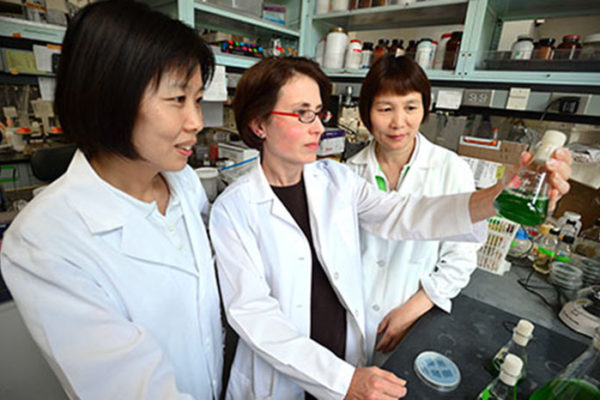Sharp teeth. Camouflage. Poisoned flowers. Brains.
The diversity of the natural world is, in a sense, a byproduct of one of the fundamental features of living organisms: they mostly “want” to stay alive long enough, at least, to procreate. Over billions of years, all sorts of clever traits have evolved in service of this goal.
So imagine trying to program an organism to self-destruct.
That is what Tae Seok Moon, associate professor in the Department of Energy, Environmental & Chemical Engineering in the McKelvey School of Engineering at Washington University in St. Louis, is trying to do. The USDA has recently awarded him a $498,771 grant in an effort to develop a “kill-switch” for genetically engineered bacteria.

For this project, Moon will be working on a self-destruct mechanism for bacteria that will be genetically engineered to destroy pathogens in the gut of livestock. Once the bacteria have completed that task in the gut, the switches will turn on and they will kill themselves.
“Killing microbes is relatively easy. You can use chemical killing agents such as alcohols or bleach,” Moon said. Getting them to kill themselves? It’s one of the most challenging control tasks Moon has been working on; he’s been at it for years.
His ideas came from considering the concerns people have about the potential of releasing genetically engineered organisms into the world. Ecosystems are complex, as is assessing the consequences of a newly introduced microorganism.
The USDA project clearly illustrates the gravity of this issue. Without a kill switch, after the engineered bacteria have done their job in the gut, they would be released together with feces into the environment. The consequences would be difficult to assess.
“What if we can prevent their spread and prolonged survival in the environment?” Moon had asked himself. “I started to think about developing genetically programmed biocontainment circuits, instead of walking behind a cow all day and spraying chemical killing agents whenever it defecates.”
To understand what Moon wants to do eventually, first it’s best to understand how he views bacteria.
“I see bacteria as systems that consist of genetic sensors, circuits and actuators,” he said. Bacteria use sensors to gather chemical and environmental information. Their circuits interpret those inputs and relay directions to the actuators, which make the appropriate move — moving toward a nutrient, for example.
These abilities evolved for the bacteria’s survival. “My key question is: Can we combine those sensors, circuits and actuators in a human-defined manner? If so,” Moon said, “we can use bacteria for our purposes.”
Nearly endless possibilities
Those possibilities are nearly endless. Moon’s current grant is being funded to engineer a kill switch for pathogen-killing bacteria. In this case, the bacteria will have two purposefully engineered circuits: one to destroy the pathogen; and the other is for self-destruction, turning on after the pathogens have been eliminated and the engineered bacteria have been released into the environment.
But what if you wanted to use bacteria to clear toxins from a drinking water supply? Or even to treat diseases in humans?
“You can imagine a lot of real-world applications,” Moon said. Ultimately, he wants to build a generalizable — almost modular — kill switch that can be integrated into any genetically modified bacteria that contain application-relevant sensors, circuits and actuators.
This is Moon’s long-term goal. His lab has already developed a variety of sensors for temperature, pH, oxygen levels, light, toxic pollutants and disease-related chemicals.
Concerning the livestock: “When released from the animal gut, bacteria usually experience temperature downshift,” Moon said. “We can build temperature-dependent kill switches that trigger self-destruction in response to the lower ambient temperature.”
With correct sensors and circuits, Moon said, “Bacteria will do everything autonomously: from accomplishing their assigned mission to killing themselves. However, all the experiments will be performed only in the controlled lab environment, and there will be no field studies or no release of engineered microbes in this project.”
There are key challenges to overcome — coping with mutation, preventing premature triggering of the kill switch and ensuring complete self-destruction — but this USDA-funded project will help Moon’s lab move beyond them, toward a generalized, modular kill switch that can keep any engineered organisms from escaping into the environment.



